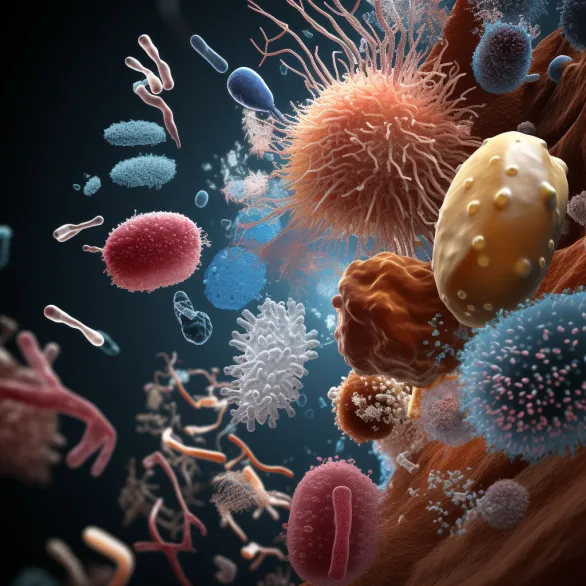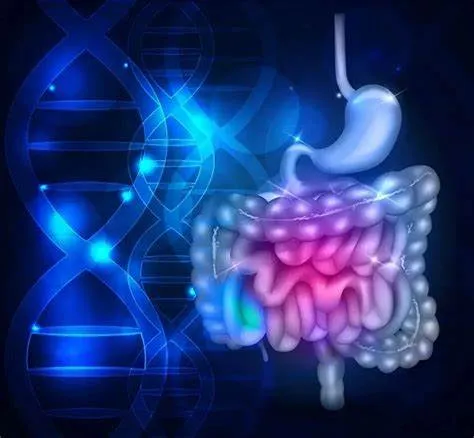
The Microbiome and Its Role in Osteoporosis
Introduction
The microbiome comprises a diverse community of microorganisms that inhabit various parts of the human body, including the intestines, skin, mouth, and other surfaces. This intricate ecosystem encompasses bacteria, viruses, fungi, and other tiny organisms that interact with our bodies and each other. Maintaining a balanced microbiome is crucial for promoting optimal health.
The Gastrointestinal Microbiome
The digestive system is home to a diverse and dynamic community of microorganisms known as the gastrointestinal microbiome. This ecosystem includes over 1,000 distinct microbial species and more than one trillion individual microorganisms. Intriguingly, the genetic diversity within the gastrointestinal microbiome exceeds that of the human genome by a factor of 100. This extensive genetic repertoire significantly influences the body’s natural functions and activities.
The development of the gastrointestinal microbiome begins at birth and gradually stabilizes by the age of three. A variety of factors, such as sex, age, genetics, diet, lifestyle, medications, antibiotic use, environmental influences, and existing health conditions, profoundly affect the composition and abundance of the microbiome.
Interactions between the human body and the gut microbiome play vital roles in numerous physiological functions, including digestive health, endocrine processes, nutrient production and absorption, energy metabolism, immune modulation, and pathogen defense. However, when the natural composition of the gut microbiome is disrupted, its functional capabilities are compromised. This disruption, known as dysbiosis, is characterized by decreased diversity and abundance of beneficial bacteria within the gastrointestinal microbiome.
In recent years, numerous studies have linked gastrointestinal dysbiosis to various illnesses and conditions, such as obesity, Alzheimer’s disease, Parkinson’s disease, autism spectrum disorder, metabolic syndrome, inflammatory bowel disease, type 2 diabetes, and cardiovascular diseases. Notably, dysbiosis has also been associated with vascular diseases, cancers, and osteoporosis. This article explores the microbiome’s impact on bone health and its role in preventing osteoporosis.

Osteoporosis: A Global Health Issue
Osteoporosis is a serious global health problem that affects millions of individuals worldwide. This condition arises from a continuous process of bone remodeling, which is managed by two specialized types of bone cells: osteoblasts and osteoclasts. Osteoblasts are responsible for bone formation, while osteoclasts break down and resorb bone tissue. An imbalance between these two processes can lead to significant bone health issues.
The Balance of Bone Remodeling
When osteoblast activity exceeds that of osteoclasts, the result is excessive bone formation, which can restrict the body’s available resources, alter bone shape, and increase the risk of fractures. Conversely, when osteoclasts outpace osteoblasts, excessive bone destruction occurs, leading to weakened bones and a heightened fracture risk.
Maintaining equilibrium between bone formation and resorption is crucial for preserving bone integrity and overall health. When this balance is disrupted, individuals may experience various bone disorders, with osteoporosis being one of the most common.
The Impact of Osteoporosis
According to the World Health Organization (WHO), osteoporosis affects approximately 200 million people globally, classifying it as a major public health concern. The WHO defines osteoporosis as a systemic skeletal disease characterized by low bone density and the deterioration of bone tissue. This condition severely compromises bone strength and structure, resulting in increased fragility and susceptibility to fractures.
Often referred to as a “silent killer” or “iceberg disease,” osteoporosis typically progresses gradually, making it difficult for individuals to recognize the issue until significant damage has occurred. The most common fractures associated with osteoporosis occur in the spine, hip, and forearm, and these injuries can profoundly impact mental health and quality of life.
Consequences of Osteoporotic Fractures
Fractures due to osteoporosis can lead to severe pain, loss of independence, decreased height, body deformities, and stooped posture. These complications not only affect physical health but also have lasting implications for emotional well-being, significantly reducing an individual’s quality of life.
In summary, osteoporosis is a critical global health issue that warrants greater awareness and proactive management to mitigate its impact on individuals and society as a whole

Two Key Factors Influencing Osteoporosis
Osteoporosis is influenced by several factors, among which age and gender play significant roles. Research clearly shows that women are more susceptible to this condition than men. In fact, statistics indicate that one in three women and one in five men over the age of 50 will experience osteoporosis at some point in their lives. Additionally, the risk of developing osteoporosis increases with advancing age; an alarming 55% of individuals aged 50 and older are at risk of this debilitating disease.
The Role of the Microbiome in Osteoporosis Prevention
Bone health is affected by a variety of elements, including diet, genetics, metabolic health, micronutrients, and environmental factors. Recent studies have underscored the important role of the gastrointestinal microbiome in the development and prevention of osteoporosis. Research has identified significant differences in the microbiome composition of individuals with osteoporosis compared to those who are healthy.
The human digestive system harbors four primary groups of microorganisms in its microbiome: Bacteroidetes, Firmicutes, Proteobacteria, and Actinobacteria. Notably, species from the Bacteroidetes and Firmicutes phyla make up over 90% of a healthy gastrointestinal microbiome.

The Microbiome's Role in Bone Health
| Effective bacteria on BMD | Bacteria with negative effects on BMD |
|---|---|
| Bifidobacterium | Bacteroidetes |
| Lachnospiraceae | Lactobacillus |
| Clostridium Cluster XIVa | Eggerthella |
| Veillonella | Dialister |
| Blautia | Enterobacter |
| Succinivibrio | |
| Pseudomonas | |
| Klebsiella |
The Microbiome's Role in Bone Health
Bone metabolism is influenced by various mechanisms of the gut microbiome. Here are some key ways in which the microbiome impacts bone health:
- Regulation of Bone Metabolism Through Metabolic Processes
The gastrointestinal microbiome is essential for absorbing minerals and synthesizing vital vitamins necessary for optimal bone health. Important substances include:
- Short-Chain Fatty Acids (SCFAs): These compounds enhance calcium absorption by lowering intestinal pH.
- Vitamin D: Crucial for calcium absorption and stimulating bone growth.
- Vitamin K: Plays a protective role against osteoporosis and promotes bone development.
- Modulation of the Immune System
The epithelial lining of the gastrointestinal tract serves as the body’s first line of defense against pathogens and antigens. A healthy gut microbiome maintains the integrity of this barrier. However, dysbiosis (an imbalance in the microbiome) can compromise gut function, allowing harmful agents to penetrate the intestinal walls. This triggers an inflammatory response, which can lead to increased osteoclast activity, damaging bone tissue and contributing to osteoporosis. In severe cases, pathogens may enter the bloodstream, reach the bones, and cause inflammation. Thus, a healthy microbiome is vital for preventing such issues by modulating the immune response, competing against pathogens, and ensuring tight junctions between intestinal cells.
- Regulation of Bone Metabolism Through Hormonal Mechanisms
The gut microbiome can also indirectly influence bone metabolism through the endocrine system. Key hormonal mechanisms include:
- Serotonin Regulation: Approximately 90% of the body’s serotonin is produced in the gut. The serotonin from the stomach is involved in bone resorption, while serotonin from the brain promotes bone formation.
- Parathyroid Hormone (PTH): This hormone, produced by the parathyroid glands, regulates calcium levels in the blood and is crucial for skeletal growth and balance. PTH enables calcium absorption into bones and stimulates bone formation. When combined with butyric acid (a SCFA produced by the microbiome), PTH encourages the conversion of CD4 immune cells into Treg cells, thus stimulating osteoblasts. Dysbiosis can reduce PTH’s positive effects on bone health, exacerbating osteoporosis.
- Insulin-Like Growth Factor 1 (IGF-1): This growth hormone, primarily synthesized in the liver, promotes bone growth directly and indirectly through its influence on skeletal muscles. Research indicates that the gut microbiome can modulate IGF-1 levels, influencing bone formation. SCFAs stimulate liver cells to produce IGF-1, further supporting bone health.
- Estrogen Regulation: Estrogen is critical for bone growth and maintenance. In postmenopausal women, decreased estrogen levels lead to significant bone mass loss, resulting in osteoporosis. Recent studies suggest that the gut microbiome can affect estrogen levels by regulating the “estrobolome,” a collection of gut bacterial genes that metabolize estrogen. These bacteria can convert estrogen precursors into active estrogen, enhancing bone formation by binding to estrogen receptors on bone cells.
Targeting the Microbiome for Osteoporosis Management
Addressing osteoporosis and related bone disorders by targeting the gastrointestinal microbiome shows promise. Approaches include:
- Probiotic Treatments: These can enhance the gut microbiome and help prevent bone disorders associated with dysbiosis.
- Phage Therapy: This innovative treatment aims to reverse dysbiosis and restore a healthy microbiome in individuals at risk of bone disorders.
By focusing on the gut microbiome, we can develop effective strategies to manage osteoporosis and improve bone health.
Conclusion
The gut microbiome plays a significant and multifaceted role in maintaining bone health and preventing osteoporosis. By understanding how the microbiome influences bone metabolism, nutrient absorption, and hormonal regulation, we can develop innovative strategies for osteoporosis management and support. As research in this area advances, it offers promising insights into how we can leverage the microbiome to enhance bone health across all stages of life.

